 | –≠–ª–µ–∫—Ç—Ä–æ–Ω–Ω—ã–π –∫–æ–º–ø–æ–Ω–µ–Ω—Ç: MIC2016 | –°–∫–∞—á–∞—Ç—å:  PDF PDF  ZIP ZIP |

MIC2006/2016
Fixed Current Limit
Power Distribution Switch
Kickstart is a trademark of Micrel, Inc
MLF and
Micro
LeadFrame are trademarks of Amkor Technology, Inc.
Micrel Inc. ∑ 2180 Fortune Drive ∑ San Jose, CA 95131 ∑ USA ∑ tel +1 (408) 944-0800 ∑ fax + 1 (408) 474-1000 ∑ http://www.micrel.com
General Description
The MIC2006 and the MIC2016 are current limiting,
high-side power switches, designed for general purpose
power distribution and control in PCs, PDAs, printers
and other self-powered systems.
The MIC2006 and MIC2016's primary functions are
current limiting and power switching. They are thermally
protected and will shut down should their internal
temperature reach unsafe levels, protecting both the
device and the load, under high current or fault
conditions. Both devices are fully self-contained, with
the current limit value being factory set to one of several
convenient levels.
The MIC2006 and the MIC2016 both feature Dynamic
Load Management (DLM), a novel adaptive current limit
which responds to changing system conditions while
maintaining the primary fixed current limit. DLM is ideal
for systems having dual mode operation (wake and
sleep states) where system power supply capabilities
vary depending upon operating mode.
The MIC2016 offers an additional unique new feature:
Kickstart
TM
, which allows momentary high current
surges to pass unrestricted without sacrificing overall
system safety.
The MIC2006 and the MIC2016 are offered in space
saving 6-pin SOT-23 and 2mm x 2mm MLF packages.
Data sheets and support documentation can be found
on Micrel's web site at: www.micrel.com.
Features
∑ 70m typical on-resistance
∑ 2.5V - 5.5V operating range
∑ Pre-set current limit values; 0.5A, 0.8A and 1.2A
∑ Dynamic Load Management
∑ Kickstart
TM
∑ User adjustable output slew rate control
∑ Thermal Protection
∑ Under voltage lock-out
∑ Adjustable slew rate limited Turn-ON
∑ Low quiescent current
Applications
∑ USB / IEEE 1394 Power Distribution
∑ Desktop and Laptop PCs
∑ Set top boxes
∑ Game
consoles
∑ PDAs
∑ Printers
∑ Docking stations
∑ Chargers
_________________________________________________________________________________________________________
Typical Application
VIN
D+/D-
D+/D-
5V Supply
CSLEW
VOUT
GND
DLM
ENABLE
MIC2006
MIC2016
USB
Controller
V
BUS
V
BUS
USB
Port
USB
Port
Figure 1. Typical Application Circuit
August 2005
M9999-080305
(408) 955-1690

Micrel, Inc.
MIC2006/MIC2016
August 2005
2
M9999-080305
408) 955-1690
MIC2000 Family Members
Part Number
Pin Function
Normal Limiting
Kickstart
I Limit
I Adj.
Enable
C
SLEW
FAULT/ DLM*
Load
Discharge
2003 2013
--
--
--
--
--
--
2004 2014
--
-- -- --
2005 2015
--
-- --
2006 2016
Fixed
--
-- --
2007 2017
-- --
2008 2018
-- -- --
2009 2019
Adj.
-- -- --
* Dynamic Load Management Adj = Adjustable current limit
Fixed = Factory programmed current limit
Ordering Information
Part Number
Marking
(1)
Current Limit
Kickstart
Pb-Free
Package
MIC2006-0.5YM6
FG05
0.5A
MIC2006-0.8YM6
FG08
0.8A
MIC2006-1.2YM6
FG12
1.2A
SOT-23-6
MIC2006-0.5YML
(2)
G05
0.5A
MIC2006-0.8YML
(2)
G08
0.8A
MIC2006-1.2YML
(2)
G12
1.2A
No
2mmX2mm MLF
MIC2016-0.5YM6
FP05
0.5A
MIC2016-0.8YM6
FP08
0.8A
MIC2016-1.2YM6
FP12
1.2A
SOT-23-6
MIC2016-0.5YML
(2)
P05
0.5A
MIC2016-0.8YML
(2)
P09
0.8A
MIC2016-1.2YML
(2)
P12
1.2A
Yes
Yes
2mmX2mm MLF
Notes:
1. Under-bar symbol ( _ ) may not be to scale
2. Contact factory for availability.

Micrel, Inc.
MIC2006/MIC2016
August 2005
3
M9999-080305
408) 955-1690
Pin Configuration
N
O
D
A
P
E
D
I
S
K
C
A
B
D
N
U
O
R
G
S
I
V
OUT
1
2
3
4
5
6
C
SLEW
DLM
V
IN
GND
ENABLE
6-Pin 2mm x 2mm MLF (ML)
Top View
V
OUT
C
SLEW
DLM
V
IN
GND
ENABLE
3
1
6
2
4
5
SOT 23-6 (M6)
Top View
Pin Description
Pin
Number
SOT-23
Pin
Number
MLF
Pin
Name
Type Description
1 6
VIN
Input
Supply input. This pin provides power to both the output switch and the
MIC2006/2016's internal control circuitry.
2 5
GND
--
Ground.
3 4
ENABLE
Input
Output enable pin. A logic HIGH activates the output switch, applying power to
the load attached to V
OUT
.
4 3
DLM
Output
Dynamic Load Management. Monitors input voltage through a resistor divider
between VIN and GND. Shuts off switch if voltage falls below the threshold set
by the resistor divider.
5 2
CSLEW
Input
Slew rate control. Adding a small value capacitor between this pin and VIN
slows turn-ON of the power FET.
6 1
VOUT
Output
Switch output. The load being driven by MIC2006/2016 is connected to this
pin.

Micrel, Inc.
MIC2006/MIC2016
August 2005
4
M9999-080305
408) 955-1690
Absolute Maximum RatingsP
(1)
V
IN
, V
OUT
............................................................ ≠0.3 to 6V
All other pins.................................................. ≠0.3 to 5.5V
Power Dissipation.................................. Internally Limited
Continuous Output Current..................................... 2.25A
Maximum Junction Temperature........................... 150
∞C
Storage Temperature .............................. ≠65
∞C to 150∞C
Operating Ratings
(2)
Supply Voltage............................................. 2.5V to 5.5V
Continuous Output Current Range .................... 0 to 2.1A
Ambient Temperature Range ....................≠40
∞C to 85∞C
Package Thermal Resistance (
JA
)
SOT-23-6
.............................................
230∞C/W
MLF 2mm x2mm ..................................... 90∞C/W
MLF 2mm x 2mm
JC
(5)
........................... 45∞C/W
Electrical Characteristics
V
IN
= 5V, T
AMBIENT
= 25
∞C unless specified otherwise. Bold indicates ≠40∞C to +85∞C limits.
Symbol Parameter
Conditions
Min
Typ
Max
Units
V
IN
Switch Input Voltage
2.5
5.5
V
I
IN
Internal Supply Current
Switch = OFF,
ENABLE = 0V
1 5
µA
I
IN
Internal Supply Current
Switch = ON, I
OUT
= 0
ENABLE = 1.5V
80
330
µA
I
LEAK
Output Leakage Current
V
IN
= 5V, V
OUT
= 0 V,
ENABLE = 0
12
100
µA
70
100
m
R
DS(ON)
Power Switch Resistance
V
IN
= 5V, I
OUT
= 100 mA
125
m
I
LIMIT
Current Limit: ≠0.5
V
OUT
= 0.8V
IN
0.5
0.7 0.9 A
I
LIMIT
Current Limit: ≠0.8
V
OUT
= 0.8V
IN
0.8
1.1 1.5 A
I
LIMIT
Current Limit: ≠1.2
V
OUT
= 0.8V
IN
1.2
1.6 2.1 A
I
LIMIT_2nd
Secondary current limit
(Kickstart)
MIC2016, V
IN
= 2.5V
2.2
4
6
A
DLM
THRESHOLD
Dynamic Load Management
threshold
225
250
275
mV
I
IN_DLM
Input Current ≠ DLM pin
1
10
µA
V
IL
(max.)
0.5
V
EN
ENABLE Input Voltage
V
IH
(min.)
1.5
V
I
EN
ENABLE Input Current
V
EN
= 0V to 5.0V
1
5
µA
T
J
increasing
145
OT
THRESHOLD
Over-temperature Threshold
T
J
decreasing
135
∞C

Micrel, Inc.
MIC2006/MIC2016
August 2005
5
M9999-080305
408) 955-1690
AC Characteristics
Symbol Parameter
Condition
Min
Typ
Max
Units
t
RISE
Output turn-ON rise time
R
L
= 10
, C
LOAD
= 1
µF,
V
OUT
= 10% to 90%
500 1000 1500
µs
t
D_LIMIT
Delay before current limiting
MIC2016
77
128
192
ms
t
RESET
Delay before resetting
Kickstart current limit delay,
t
D_LIMIT
Out of current limit following a
current limit event.
MIC2016
77
128
192
ms
t
ON_DLY
Output Turn-on Delay
R
L
= 43
, C
L
= 120µF,
C
SLEW
10pF,
V
EN
= 50% to V
OUT
= 10%
1000
1500
µs
t
OFF_DLY
Output Turn-off Delay
R
L
= 43
, C
L
= 120µF,
C
SLEW
10pF,
V
EN
= 50% to V
OUT
= 90%
700
µs
t
DLY_DLM
Delay before disengaging
load
20
32
49
ms
t
OFF_DLM
OFF time after disengaging
load
77
128
192
ms
ESD
Symbol Parameter
Condition
Min
Typ
Max
Units
V
OUT
and GND
± 4
kV
V
ESD_HB
Electro Static Discharge
Voltage: Human Body Model
All other pins
± 2
kV
V
ESD_MCHN
Electro Static Discharge
Voltage; Machine Model
All pins
Machine Model
± 200
V
Notes:
1. Exceeding the absolute maximum rating may damage the device.
2. The device is not guaranteed to function outside its operating rating.
3. Devices are ESD sensitive. Handling precautions recommended. Human body model, 1.5k in series with 100pF.
4. Specification for packaged product only.
5. Requires proper thermal mounting to achieve this performance.

Micrel, Inc.
MIC2006/MIC2016
August 2005
6
M9999-080305
408) 955-1690
Timing Diagrams
ENABLE
VOUT
50%
90%
10%
t
ON_DLY
t
OFF_DLY
50%
Switching Delay Times
90%
10%
90%
10%
t
FALL
t
RISE
Rise and Fall Times
90%
10%
t
RISE
VOUT
Output Rise Time
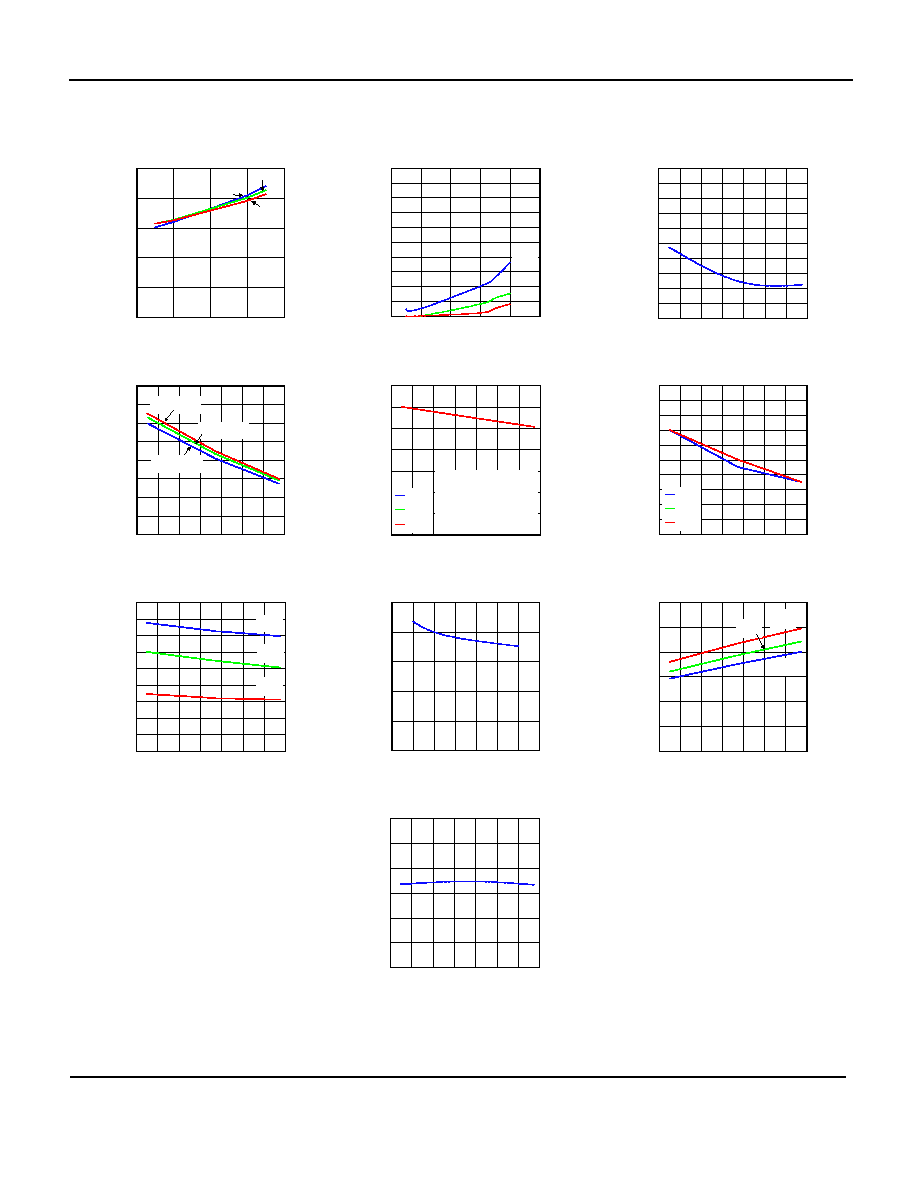
Micrel, Inc.
MIC2006/MIC2016
August 2005
7
M9999-080305
408) 955-1690
Typical Characteristics
0
20
40
60
80
100
2
3
4
5
6
SUP
P
LY CUR
RENT
(
µ
A)
V
IN
(V)
Supply Current
Output Enabled
-40∞C
85∞C
25∞C
0
0.10
0.20
0.30
0.40
0.50
0.60
0.70
0.80
0.90
1.00
2
3
4
5
6
7
SUP
P
L
Y
CURRE
N
T
(
µ
A)
V
IN
(V)
Supply Current
Output Disabled
-40∞C
85∞C
25∞C
0
0.10
0.20
0.30
0.40
0.50
0.60
0.70
0.80
0.90
1.00
-50 -30 -10 10 30 50 70 90
(
µ
A)
TEMPERATURE (∞C)
Switch Leakage Current - OFF
1.25
1.30
1.35
1.40
1.45
1.50
1.55
1.60
1.65
-50 -30 -10 10 30 50 70 90
I
LI
M
I
T
(A
)
TEMPERATURE (∞C)
I
LIMIT
vs. Temperature
(MIC20xx-1.2)
V
IN
= 2.5V
V
IN
= 5V
V
IN
= 3V
0.00
0.20
0.40
0.60
0.80
1.00
1.20
1.40
-50 -30 -10 10 30 50 70 90
I
LI
M
I
T
(A)
TEMPERATURE (∞C)
5V
3V
2.5V
I
LIMIT
vs. Temperature
(MIC20xx - 0.8)
Note:
Please note that the
3 plots overlay each
other.
0.55
0.57
0.59
0.61
0.63
0.65
0.67
0.69
0.71
0.73
0.75
-50 -30 -10 10 30 50 70 90
I
LI
MI
T
(A
)
TEMPERATURE (∞C)
5V
3V
2.5V
I
LIMIT
vs. Temperature
(MIC20xx - 0.5)
0
0.2
0.4
0.6
0.8
1.0
1.2
1.4
1.6
1.8
-50 -30 -10 10 30 50 70 90
I
LI
MI
T
(A)
TEMPERATURE (∞C)
I
LIMIT
vs.
Temperature
1.2A
0.8A
0.5A
0
20
40
60
80
100
2
2.5
3
3.5
4
4.5
5
5.5
R
ON
(mOhm)
V
IN
(V)
R
ON
vs.
Supply Voltage
0
20
40
60
80
100
120
-50 -30 -10 10 30 50 70 90
R
ON
(mOhm)
TEMPERATURE (∞C)
R
ON
vs.
Temperature
2.5V
3.3V
5V
230.0
235.0
240.0
245.0
250.0
255.0
260.0
-50 -30 -10 10 30 50 70 90
TH
RESH
OLD
(mV)
TEMPERATURE (∞C)
DLM Threshold
vs. Temperature

Micrel, Inc.
MIC2006/MIC2016
August 2005
8
M9999-080305
408) 955-1690
Functional Characteristics
ENABLE
(2.5V/div)
V
OUT
(1V/div)
I
OUT
(150mA/div)
0
Time (µs)
2000
6000
10000
14000
18000
22000
V
IN
= 5.0V
R
LOAD
C
LOAD
= 0µF
0pF 100pF
820pF
1800pF
2700pF 3500pF
C
SLEW
Response
ENABLE
(2.5V/div)
V
OUT
(1V/div)
I
OUT
(250mA/div)
0
Time (ms)
50
100
150
200
250
300
350
400
450
500
550
V
IN
= 5.0V
R
LOAD
C
LOAD
= 47µF
Current Limit Response Thermal Shutdown
ENABLE
(2.5V/div)
V
OUT
(1V/div)
I
OUT
(0.5A/div)
0
Time (ms)
50
100
150
200
250
300
350
400
450 500
550
Kickstart Response
Normal Load with Temporary High Load
ENABLE
(1V/div)
V
OUT
(1V/div)
I
OUT
(0.5A/div)
0
Time (ms)
50
100
150
200
250
300
350 400 450 500
550
Kickstart Response
No Load to Short Circuit
ENABLE
(2.5V/div)
V
OUT
(1V/div)
I
OUT
(0.5A/div)
0
Time (ms)
50
100
150
200
250
300
350
400
450 500
550
Kickstart Response
Normal Load with Temporary Short Circuit
ENABLE
(2.5V/div)
V
OUT
(1V/div)
I
OUT
(0.5A/div)
0
Time (ms)
50
100
150
200
250
300
350
400 450 500
550
Kickstart Response
Device Enabled into a Short Circuit

Micr
MIC2006/MIC2016
el, Inc.
August 2005
9
M9999-080305
408) 955-1690
Inrush Current Response
ENABLE
(2.5V/div)
V
OUT
(1V/div)
I
OUT
(200mA/div)
0
Time (ms)
R
L
C
SLEW
= 0pF
4
8
12
16
20
24
28
32
36
40
MIC20xx-0.5
0µF
10µF
22µF47µF 100µF
220µF
470µF
ENABLE
(2.5V/div)
V
OUT
(1V/div)
I
OUT
(200mA/div)
0
Time (ms)
2
4
6
8
10
12
14
V
IN
= 5.0V
R
LOAD
C
LOAD
= 100µF
Turn-On/Turn-Off
ENABLE
(2.5V/div)
V
OUT
(1V/div)
V
IN
(1/div)
0
Time (µs)
20
40
60
80
100
120
140
160
180
200
DLM

Micrel, Inc.
MIC2006/MIC2016
August 2005
10
M9999-080305
408) 955-1690
Functional Diagram
V
F
E
R
r
e
w
o
P
T
E
F
r
e
d
n
U
e
g
a
tl
o
V
r
o
t
c
e
t
e
D
l
a
m
r
e
h
T
r
o
s
n
e
S
e
t
a
R
w
e
l
S
l
o
r
t
n
o
C
t
n
e
r
r
u
C
T
E
F
r
o
r
ri
M
y
r
o
t
c
a
F
d
e
t
s
u
j
d
a
ti
m
i
L
t
n
e
r
r
u
C
p
o
o
L
l
o
r
t
n
o
c
l
o
r
t
n
o
C
e
t
a
G
c
i
g
o
L
l
o
r
t
n
o
C
r
e
m
i
T
y
a
l
e
D
d
n
a
ENABLE
DLM
CSLEW
GND
VOUT
VIN
Figure 2. MIC2006/2016 Block Diagram

Micrel, Inc.
MIC2006/MIC2016
August 2005
11
M9999-080305
408) 955-1690
Functional Description
Input and Output
V
IN
is both the power supply connection for the internal
circuitry driving the switch and the input (Source
connection) of the power MOSFET switch. V
OUT
is the
Drain connection of the power MOSFET and supplies
power to the load. In a typical circuit, current flows from
V
IN
to V
OUT
toward the load. Since the switch is bi-
directional when enabled, if V
OUT
is greater than V
IN
,
current will flow from V
OUT
to V
IN
.
When the switch is disabled, current will not flow to the
load, except for a small unavoidable leakage current of
a few microamps. However, should V
OUT
exceed V
IN
by
more than a diode drop (~0.6V), while the switch is
disabled, current will flow from output to input via the
power MOSFET's body diode. This effect can be used
to advantage when large bypass capacitors are placed
on MIC2006/2016's's output. When power to the switch
is removed, the output capacitor will be automatically
discharged.
If discharging C
LOAD
is required by your application,
consider using the MIC2004/2014 or the MIC2007/2017
in place of the MIC2006/2016. These MIC2000 family
members are equipped with a discharge FET to insure
complete discharge of C
LOAD
.
Current Sensing and Limiting
The MIC2006/2016 protects the system power supply
and load from damage by continuously monitoring
current through the on-chip power MOSFET. Load
current is monitored by means of a current mirror in
parallel with the power MOSFET switch. Current limiting
is invoked when the load exceeds an internally set over-
current threshold. When current limiting is activated, the
output current is constrained to the limit value, and
remains at this level until either the load/fault is
removed, the load's current requirement drops below
the limiting value, or the MIC2006/2016 goes into
thermal shutdown.
Kickstart (MIC2016 only)
The MIC2016 is designed to allow momentary current
surges (Kickstart) before the onset of current limiting,
which permits dynamic loads, such as small disk drives
or portable printers to draw the energy needed to
overcome inertial loads without sacrificing system
safety. In this respect, the MIC2016 differs markedly
from MIC2006 and its peers, which immediately limit
load current, potentially starving the motor and causing
the appliance to stall or stutter.
During this delay period, typically 128 ms, a secondary
current limit is in effect. If the load demands a current in
excess of the secondary limit, MIC2016 acts
immediately to restrict output current to the secondary
limit for the duration of the Kickstart period. After this
time, the MIC2016 reverts to its normal current limit. An
example of Kickstart operation is shown below.
T
U
O
T
U
O
Figure 3. Kickstart Operation
Picture Key:
A) MIC2016 is enabled into an excessive load (slew
rate limiting not visible at this time scale) The initial
current surge is limited by either the overall circuit
resistance and power supply compliance, or the
secondary current limit, whichever is less.
B) R
ON
of the power FET increases due to internal
heating (effect exaggerated for emphasis).
C) Kickstart period.
D) Current limiting initiated. FAULT/ goes LOW (Note:
FAULT/ output not available on MIC2016).
E) V
OUT
is non-zero (load is heavy, but not a dead short
where V
OUT
= 0. Limiting response will be the same
for dead shorts).
F) Thermal shutdown followed by thermal cycling.
G) Excessive load released, normal load remains.
MIC201x drops out of current limiting.
H) FAULT/ delay period followed by FAULT/ going
HIGH (FAULT/ output not available on MIC2016).
Dynamic Load Management (DLM)
Dynamic Load Management functions as a second
current limit by monitoring the VIN pin and watching for
a drop in voltage, indicating excessive loading of the
supply. When detected MIC2006/2016 disengages the
load to protect the supply and allow VIN to recover. After
128 ms has elapsed, the MIC2006/2016 re-engages the
load and monitors VIN. If VIN drops again, then the

Micrel, Inc.
MIC2006/MIC2016
August 2005
12
M9999-080305
408) 955-1690
MIC2006/2019 will disengage the load and wait another
128 ms before reconnecting. The MIC2006/2016 will
continue to cycle the load until either Enable Low, the
offending load is removed or sufficient power becomes
available to support the load without VIN sagging.
Enable
ENABLE is a HIGH true control signal, which activates
the main MOSFET switch. ENABLE will operate with
logic running from supply voltages as low as 1.8V.
ENABLE can be wire-OR'd with other MIC2006/2016s
or similar devices without damage to the device.
ENABLE may be driven higher than V
IN
, but no higher
than 5.5V.
Slew Rate Control
Large capacitive loads can create significant current
surges when charged through a high-side switch such
as the MIC2006/2016. For this reason, MIC2006/2016
provides built-in slew rate control to limit the initial inrush
currents upon enabling the power MOSFET switch.
Slew rate control is active upon powering up, and upon
re-enabling the load. At shutdown, the discharge slew
rate is controlled by the external load and output
capacitor.
On the MIC2006/2016 Slew Rate is adjustable and can
be further reduced by adding an external capacitance
between VIN and the CSLEW pins.
Thermal Shutdown
Thermal shutdown is employed to protect the
MIC2006/2016 from damage should the die temperature
exceed safe operating levels. Thermal shutdown shuts
off the output MOSFET if the die temperature reaches
145∞C.
The MIC2006/2016 will automatically resume operation
when the die temperature cools down to 135∞C. If
resumed operation results in reheating of the die,
another shutdown cycle will occur and the
MIC2006/2016 will continue cycling between ON and
OFF states until the offending load has been removed.
Depending upon PCB layout, package type, ambient
temperature, etc., hundreds of milliseconds may elapse
from the incidence of a fault to the output MOSFET
being shut off. This delay is due to thermal time
constants within the system itself. In no event will the
device be damaged due to thermal overload because
die temperature is monitored continuously by on-chip
circuitry.

Micrel, Inc.
MIC2006/MIC2016
August 2005
13
M9999-080305
408) 955-1690
Application Information
I
LIMIT
vs. I
OUT
measured
The MIC2006/2016's current limiting circuitry is
designed to act as a constant current source to the load.
As the load tries to pull more than the allotted current,
V
OUT
drops and the input to output voltage differential
increases. When V
IN
-V
OUT
exceeds 1V, I
OUT
drops below
I
LIMIT
to reduce the drain of fault current on the system's
power supply and to limit internal heating of
MIC2006/2016.
When measuring I
OUT
it is important to bear this voltage
dependence in mind, otherwise the measurement data
may appear to indicate a problem when none really
exists. This voltage dependence is illustrated in Figures
4 and 5.
In Figure
4, output current is measured as V
OUT
is pulled
below V
IN
, with the test terminating when V
OUT
is 1V
below V
IN
. Observe that once I
LIMIT
is reached I
OUT
remains constant throughout the remainder of the test.
In Figure
5
this test is repeated but with V
IN
- V
OUT
exceeding 1V.
When V
IN
- V
OUT
> 1V, MIC2006/2016's current limiting
circuitry responds by decreasing I
OUT
, as can be seen in
Figure 5. In this demonstration, V
OUT
is being controlled
and I
OUT
is the measured quantity. In real life
applications V
OUT
is determined in accordance with
Ohm's law by the load and the limiting current.
Figure 4. I
OUT
in Current Limiting for V
IN
- V
OUT
1V
Figure 5. I
OUT
in Current Limiting for V
IN
- V
OUT
>1V
This folding back of I
LIMIT
can be generalized by plotting
I
LIMIT
as a function of V
OUT
, as shown below. The slope
of V
OUT
between I
OUT
= 0 and I
OUT
= I
LIMIT
(where I
LIMIT
=
1) is determined by R
ON
of MIC2006/2016 and I
LIMIT
.
0
0.2
0.4
0.6
0.8
1.0
1.2
0
1
2
3
4
5
6
NO
RMA
L
I
Z
E
D
O
U
TP
UT CURRENT
(A)
OUTPUT VOLTAGE (V)
Normalized Output Current
vs. Output Voltage (5V)
Figure 6. Caption?
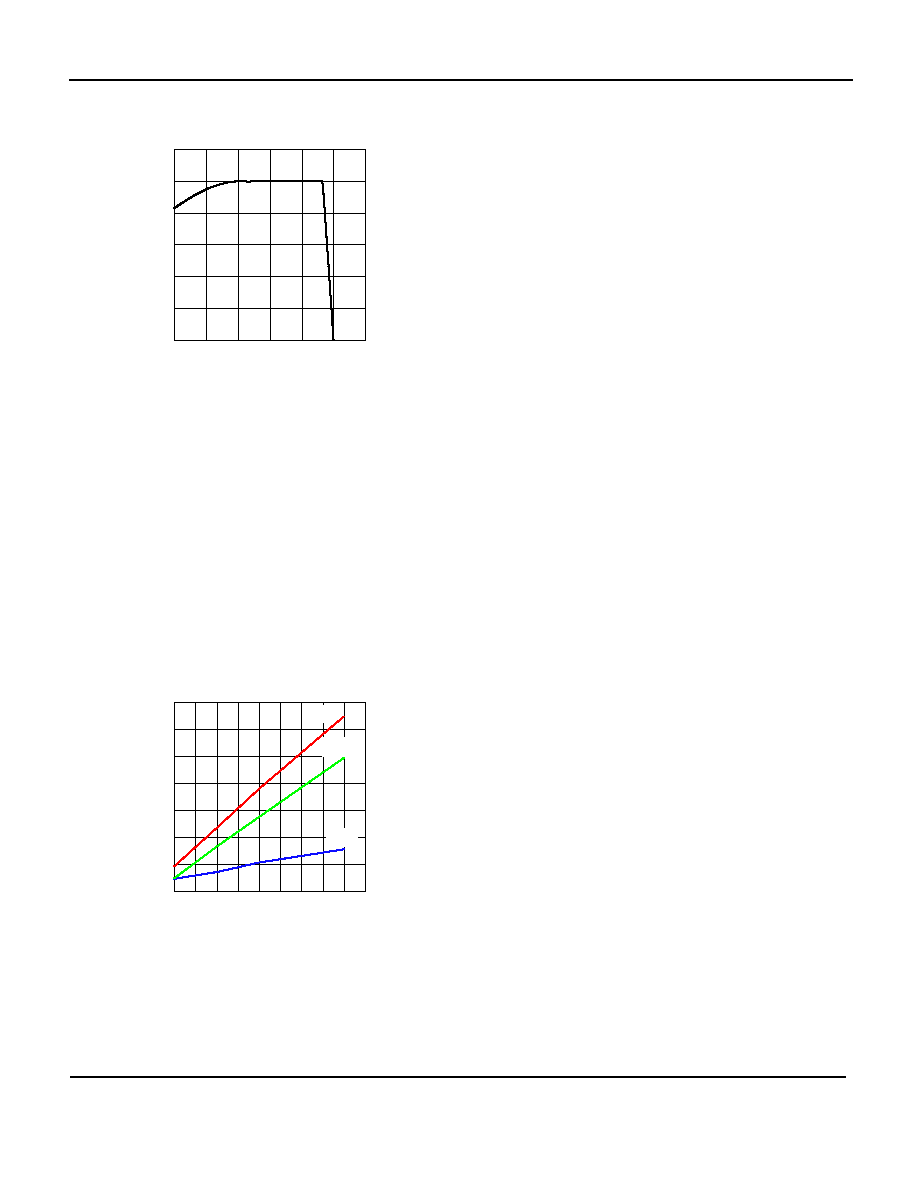
Micrel, Inc.
MIC2006/MIC2016
August 2005
14
M9999-080305
408) 955-1690
0
0.2
0.4
0.6
0.8
1.0
1.2
0
0.5 1.0 1.5
2.0 2.5 3.0
NORMALIZED
OUTPUT C
URREN
T
(
A
)
OUTPUT VOLTAGE (V)
Normalized Output Current
vs. Output Voltage (2.5V)
Figure 7. Caption?
C
SLEW
The CSLEW input is provided to increase control of the
output voltage ramp at turn-on. This input allows
designers the option of decreasing the output's slew rate
(slowing the voltage rise) by adding an external
capacitance between the pin, CSLEW, and VIN. This
capacitance slows the rate at which the pass FET gate
voltage increases and thus, slows both the response to
an Enable command as well as V
OUT
's ascent to its final
value.
Figure 8 illustrates effect of C
SLEW
on turn-ON delay and
output rise time.
0
0.002
0.004
0.006
0.008
0.01
0.012
0.014
0
0
0
0
0
0
0
0
0
0
TI
ME
(
m
S)
C
SLEW
(nF)
Typical Turn-on Times
vs. External C
SLEW
Capacitance
2
4
6
8
10
12
14
0
0 0.5 1 1.5 2 2.5 3 3.5 4 4.5
T
RISE
T
DELAY
T
ON
Figure 8. Caption?
C
SLEW
's effect on I
LIMIT
An unavoidable consequence of adding C
capacitance is a reduction in MIC2006/2016's ability to
quickly limit current transients or surges. A sufficiently
large capacitance can prevent the both the primary and
secondary current limits from acting in time to prevent
damage to MIC2006/2016 or the system from a short
circuit fault. For this reason, the upper limi
SLEW
t on the value
of C
SLEW
is 4nF.
Dynamic Load Management (DLM)
Power conscious systems, such as those implementing
ACPI, will remain active even in their low power states
and may require the support of external devices through
both phases of operation. Under these conditions, the
current allowed these external devices may vary
according to the system's operating state and as such
require dual current limits on their peripheral ports. The
MIC2006/2016 is designed for systems demanding two
primary current limiting levels but without the use of a
control signal to select between current limits.
To better understand how the MIC2006/2016 provides
this, imagine a system whose main power supply
supports multi amp loads during normal operation, but in
sleep mode is reduced to only few hundred milliamps of
output current. In addition, this system has several USB
ports which must remain active during sleep. In normal
operation, each port can support a 500mA peripheral,
but in sleep mode their combined output current is
limited to what the power supply can deliver minus
whatever the system itself is drawing.
If a peripheral device is plugged in which demands more
current than is available, the system power supply will
sag, or crash. The MIC2006/2016 prevents this by
monitoring both the load current and V
IN
. During normal
operation, when the power supply can source plenty of
current, the MIC2006/2016 will support any load up to its
factory programmed current limit. When the weaker,
standby supply is in operation, the MIC2006/2016
monitors V
IN
and will shut off its output should V
IN
dip
below a predetermined value. This predetermined
voltage is user programmable and set by the selection
of the resistor divider driving the DLM pin.
To prevent false triggering of the DLM feature, the
MIC2006/2016 includes a delay timer to blank out
momentary excursions below the DLM trip point. If V
IN
stays below the DLM trip point for longer than 32ms
(typical), then the load is disengaged and the
MIC2006/2016 will wait 128ms before reapplying power
to the load. If V
IN
remains below the DLM trip point, then
the load will be powered for the 32ms blanking period
and then again disengaged. This is illustrated in the
scope plot below. If V
IN
remains above the DLM trip
point MIC2006/2016 resumes normal operation.
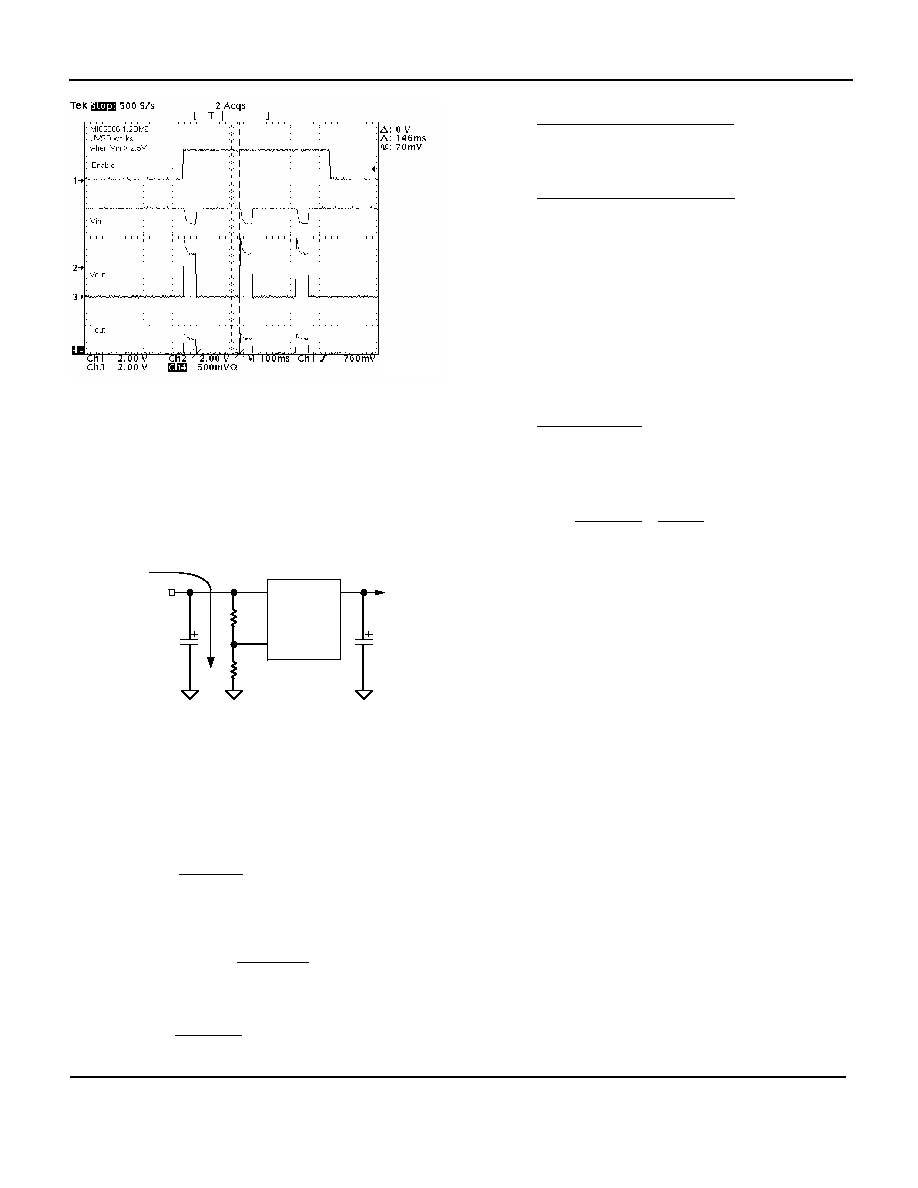
Micrel, Inc.
MIC2006/MIC2016
August 2005
15
M9999-080305
408) 955-1690
Figure 9. DLM Operation
DLM and Kickstart operate independently in the
MIC2016. If the high current surge allowed by Kickstart
causes V
IN
to dip below the DLM trip point for more than
32ms, DLM will disengage the load even though the
Kickstart timer has not timed out.
Calculating DLM resistor divider values
Input
Supply
R1
R2
I
IN_LOAD
MIC2006
MIC2016
V
IN
V
OUT
DLM
Selection of R
1
and R
2
is driven by the input voltage at
which DLM should go into effect and the allowed loading
of the input supply. The DLM comparator has a CMOS
input and as such applies minimal loading to the resistor
divider. For this reason its effect can be ignored for all
practical values of R
1
and R
2
. Starting with the loading
requirements:
(
)
1
2
_
_
R
R
V
I
MAX
IN
LOAD
IN
+
=
And then the DLM trip voltage as it relates to the
comparator threshold and the resistor divider:
(
)
1
2
2
_
R
R
R
V
V
TRIP
THRESHOLD
DLM
+
◊
=
Rearranging these:
(
)
LOAD
IN
MAX
IN
I
V
R
R
_
_
1
2
=
+
and
(
)
TRIP
THRESHOLD
DLM
V
R
R
V
R
1
2
_
2
+
◊
=
Then substituting:
LOAD
IN
TRIP
MAX
IN
THRESHOLD
DLM
I
V
V
V
R
_
_
_
2
◊
◊
=
Putting some real life values to this:
V
TRIP
= 4.75V for a nominal 5V supply.
V
IN_MAX
= 5.25V for a nominal 5V supply.
I
IN_Load
= 100
µ
A.
Then from the Electrical specifications we find:
V
DLM_Threshold
.= 250mV.
Substituting these values into the equation above:
µA
V
mV
R
100
75
.
4
25
.
5
250
2
◊
◊
=
or
R
2
= 2.76k
Then solving for R
1
(
)
=
=
+
k
µA
V
I
V
R
R
LOAD
IN
MAX
IN
5
.
52
100
25
.
5
_
_
1
2
R
1
= (52.5k -2.76k) = 49.7k
I
IN_LOAD
100
µ
A
In this example we have used the nominal value of
V
DLM_Threshold
. By substituting in the min and max values
of V
DLM_Threshold
,R1 and R2 the DLM trip point window
can be established.
The DLM comparator uses no hysteresis. This is
because the DLM blanking timer prevents any chattering
that might otherwise occur if V
IN
fluxuates about the
trigger point. The timer is reset by upward crossings of
the trip point such that V
IN
must remain below the trip
point for the full 32ms period for load disengagement to
occur.
In selecting a DLM trigger voltage the designer is
cautioned to not make this value less than 2.5V. A
minimum of 2.5V is required for the MIC2006/2016's
internal circuitry to operate properly. DLM tip points
below 2.5V will result in erratic or unpredictable
operation.
Kickstart (MIC2016)
Kickstart allows brief current surges to pass to the load
before the onset of normal current limiting, which
permits dynamic loads to draw bursts of energy without
sacrificing system safety.
Functionally, Kickstart is a forced override of the normal

Micrel, Inc.
MIC2006/MIC2016
August 2005
16
M9999-080305
408) 955-1690
current limiting function provided by the MIC2016. The
Kickstart period is governed by an internal timer which
allows current to pass unimpeded to the load for 128ms
and then normal (primary) current limiting goes into
action.
During Kickstart, a secondary current limiting circuit
monitors output current to prevent damage to the the
MIC2016, as a hard short combined with a robust power
supply can result in currents of many tens of amperes.
This secondary current limit is nominally set at 4 Amps
and reacts immediately and independently of the
Kickstart period. Once the Kickstart timer has finished its
count, then the primary current limiting circuit takes over
and holds I
OUT
to its programmed limit for as long as the
excessive load persists.
Once MIC2016 drops out of current limiting the Kickstart
timer initiates a lock-out period of 128ms such that no
further bursts of current above the primary current limit,
will be allowed until the lock-out period has expired.
Kickstart may be over-ridden by the thermal protection
circuit and if sufficient internal heating occurs, Kickstart
will be terminated and I
OUT
0. Upon cooling, if the
load is still present I
OUT
I
LIMIT
, not I
KICKSTART
.
ENABLE
V
OUT
I
OUT
0
Time (ms)
100
200
300
400
500
600
Kickstart
Current Limiting
Load Removed
Figure 9. Kickstart
Supply Filtering
A 0.1µF to 1µF bypass capacitor positioned close to the
V
IN
and GND pins of MIC2006/2016 is both good design
practice and required for proper operation of
MIC2006/2016. This will control supply transients and
ringing. Without a bypass capacitor, large current surges
or an output short may cause sufficient ringing on V
IN
(from supply lead inductance) to cause erratic operation
of MIC2006/2016's control circuitry. Good quality, low
ESR capacitors, such as Panasonic's TE or ECJ series,
are suggested.
When bypassing with capacitors of 10µF and up, it is
good practice to place a smaller value capacitor in
parallel with the larger to handle the high frequency
components of any line transients. Values in the range
of 0.01µF to 0.1µF are recommended. Again, good
quality, low ESR capacitors should be chosen.
Power Dissipation
Power dissipation depends on several factors such as
the load, PCB layout, ambient temperature, and supply
voltage. Calculation of power dissipation can be
accomplished by the following equation:
(
)
2
OUT
DS(ON)
D
I
R
P
◊
=
To relate this to junction temperature, the following
equation can be used:
A
A)
-
(J
D
J
T
R
P
T
+
◊
=
Where: T
J
= junction temperature,
T
A
= ambient temperature
R
(J-A)
is the thermal resistance of the package
In normal operation, the MIC2006/2016's Ron is low
enough that no significant I
2
R heating occurs. Device
heating is most often caused by a short circuit, or very
heavy load, when a significant portion of the input
supply voltage appears across the MIC2006/2016's
power MOSFET. Under these conditions, the heat
generated will exceed the package and PCB's ability to
cool the device and thermal limiting will be invoked.
In Figure 10, die temperature is plotted against I
OUT
assuming a constant case temperature of 85∞C. The
plots also assume a worst case R
ON
of 140 m at a die
temperature of 135∞C. Under these conditions, it is clear
that an SOT-23 packaged device will be on the verge of
thermal shutdown, typically 145∞C die temperature,
when operating at a load current of 1.25A. For this
reason, it is recommend that a MLF package be used
for any MIC2006/2016s designs intending to supply
continuous currents of 1A or more.
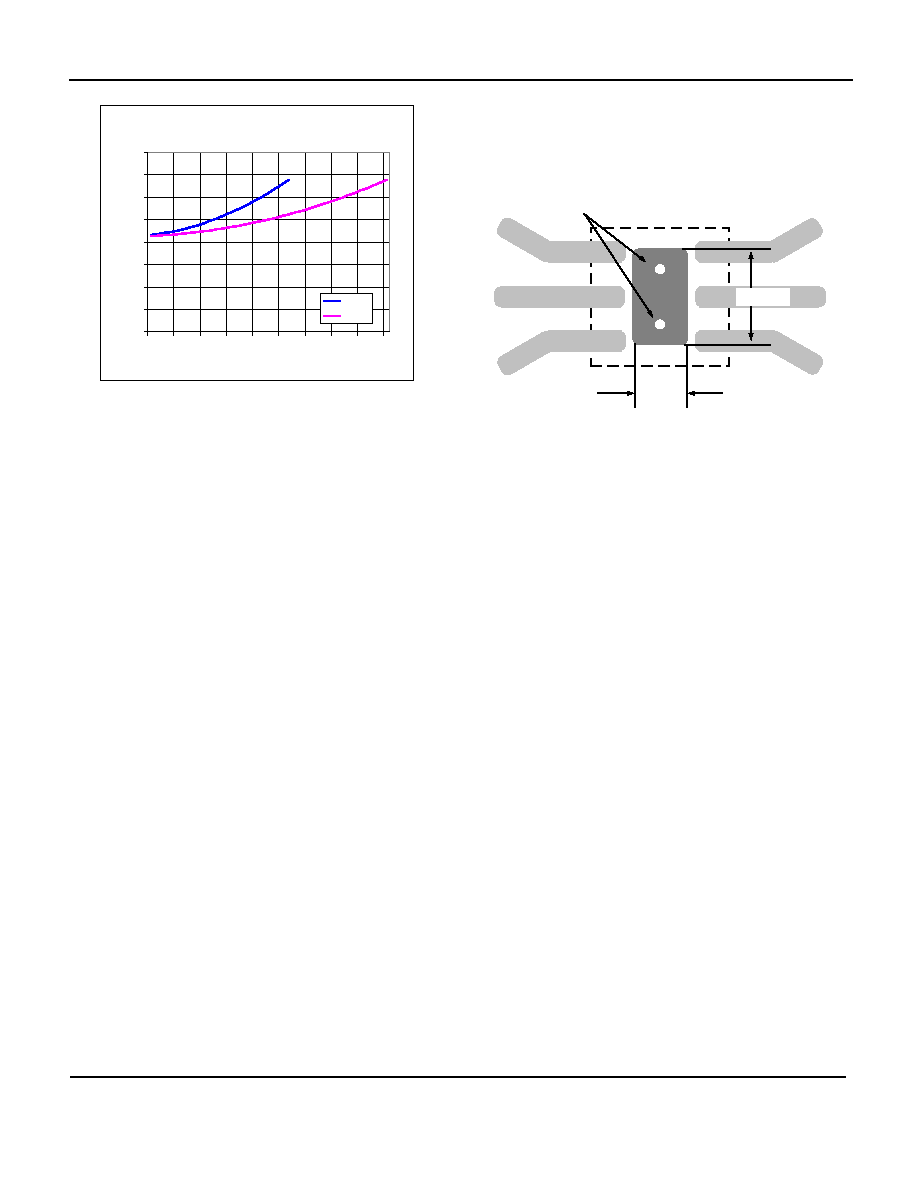
Micrel, Inc.
MIC2006/MIC2016
August 2005
17
M9999-080305
408) 955-1690
Die Temperature vs. Iout for Tcase = 85∞C
0
20
40
60
80
100
120
140
160
0.20 0.40 0.60 0.80 1.00 1.20 1.40 1.60 1.80 2.00
Iout - Amps
D
i
e T
e
m
p
er
atu
r
e
- ∞
C
SOT-23
MLF
Figure 10. Die Temperature vs. I
OUT
Figure 10 assumes no backside contact is made to the
thermal pad provided on the MLF package. For optimal
performance at higher current levels, or in higher
temperature environments, thermal contact with the
PCB and the exposed power paddle on the back side of
the MLF package should be made. This significantly
reduces the package's thermal resistance and thus
extends the MIC2006/2016's operating range. It should
be noted that this backside paddle is electrically active
and is connected to MIC2006/2016's GND pin.
2 Vias
0.3 mm diam.
to Ground Plane
0.8 mm
1.4 mm
Figure 11. Pad for thermal mounting to PCB
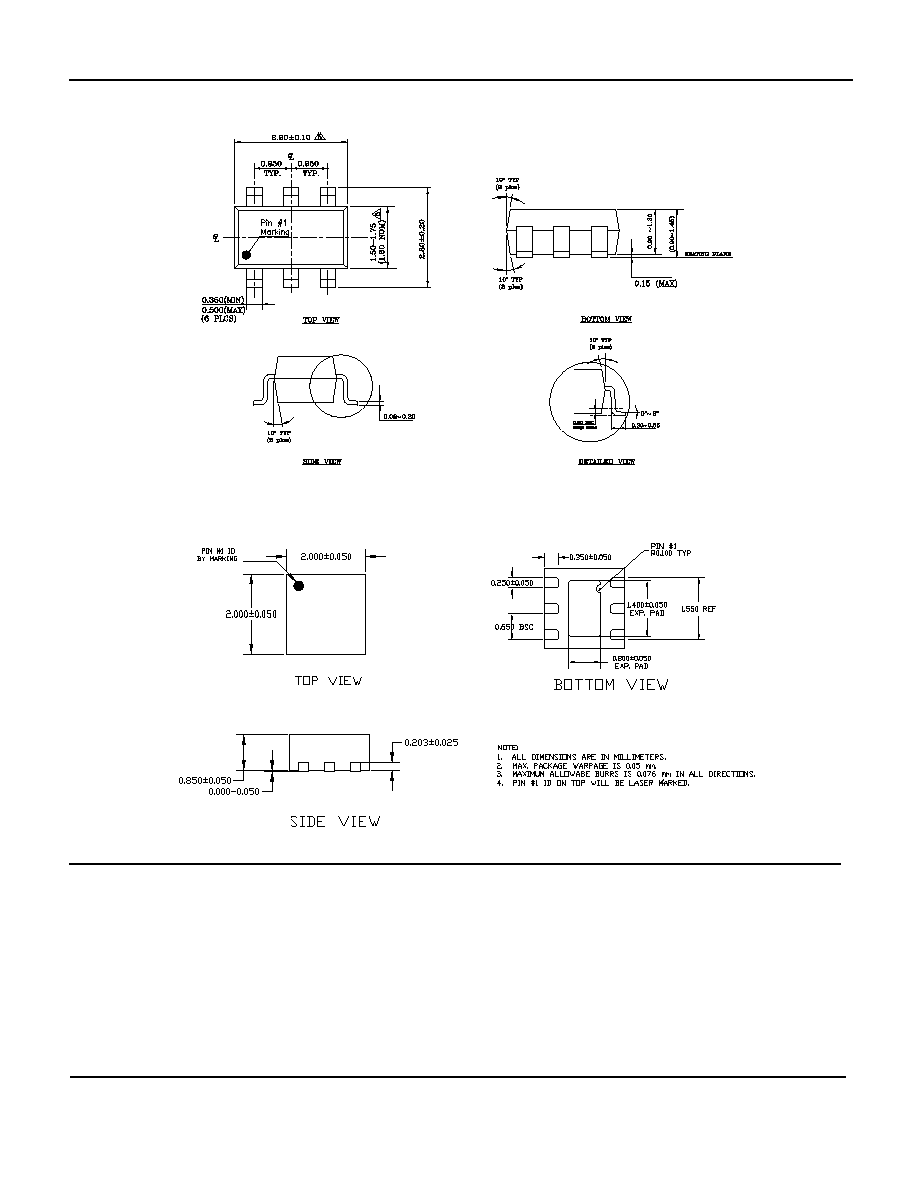
Micrel, Inc.
MIC2006/MIC2016
August 2005
18
M9999-080305
408) 955-1690
Package Information
6-Pin SOT-23 (M6)
6 Pin 2mmX2mm MLF (ML)
MICREL, INC. 2180 FORTUNE DRIVE SAN JOSE, CA 95131 USA
TEL +1 (408) 944-0800 FAX +1 (408) 474-1000 WEB http:/www.micrel.com
The information furnished by Micrel in this data sheet is believed to be accurate and reliable. However, no responsibility is assumed by Micrel for
its use. Micrel reserves the right to change circuitry and specifications at any time without notification to the customer.
Micrel Products are not designed or authorized for use as components in life support appliances, devices or systems where malfunction of a
product can reasonably be expected to result in personal injury. Life support devices or systems are devices or systems that (a) are intended for
surgical implant into the body or (b) support or sustain life, and whose failure to perform can be reasonably expected to result in a significant
injury to the user. A Purchaser's use or sale of Micrel Products for use in life support appliances, devices or systems is a Purchaser's own risk
and Purchaser agrees to fully indemnify Micrel for any damages resulting from such use or sale.
© 2005 Micrel, Incorporated.

Micrel, Inc.
MIC2006/MIC2016
August 2005
19
M9999-080305
408) 955-1690


















